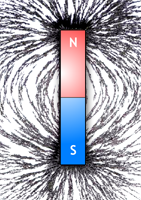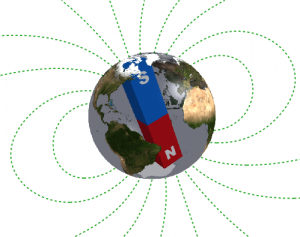The Earth's Magnetic Field
 Magnetic fields are generated in the area around magnetic materials and can cause forces to act on other magnetic materials. These materials can be magnets or electric currents (more generally, moving charged particles). This field can be ‘seen’ by spreading iron filings around a bar magnet. The filings will align themselves with the magnetic field.
Magnetic fields are generated in the area around magnetic materials and can cause forces to act on other magnetic materials. These materials can be magnets or electric currents (more generally, moving charged particles). This field can be ‘seen’ by spreading iron filings around a bar magnet. The filings will align themselves with the magnetic field.
The field generated by a bar magnet is known a dipole field, as is has two poles. The Earth’s magnetic field is also a dipole field, resembling, to a first approximation, that of the bar magnet and is generated by complex movements of the liquid iron in the Earth’s outer core. The magnetic field is tilted from the rotational axis of the Earth by about 11° placing the North magnetic pole over northern Canada. The average strength of the field near the pole is around 60,000 nT, decreasing to around 30,000 nT near the Equator (though this value is affected by processes occurring in the near-Earth region of space). The Earth's magnetic field extends far into space and can trap charged particles, similar to how the iron filings were trapped by the field around the bar magnet. This region of space is known as the magnetosphere and is the usual area investigated using the CARISMA magnetometer array.
 The Earth's magnetic field however is influenced by other magnetic fields in space (just as one magnet can cause another to move on a table, for example). The sun also has a magnetic field of it's own, which extends far into space, altering the shape of the magnetosphere. On the side pointing at he sun, the field is compressed and on the other (the night side) the field is stretched such that the whole magnetosphere resembles a teardrop.
The Earth's magnetic field however is influenced by other magnetic fields in space (just as one magnet can cause another to move on a table, for example). The sun also has a magnetic field of it's own, which extends far into space, altering the shape of the magnetosphere. On the side pointing at he sun, the field is compressed and on the other (the night side) the field is stretched such that the whole magnetosphere resembles a teardrop.









